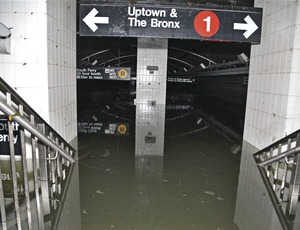The 15 million gallons of seawater that Superstorm Sandy dumped into the three-year-old South Ferry subway station in lower Manhattan are gone. What still lingers are what specific measures the Metropolitan Transportation Authority's New York City Transit division (NYCT) will take to safeguard the station when it reopens.

The $545-million South Ferry subway station at Manhattan's southern tip opened in spring 2009 with platforms long enough to accommodate 10-car trains rather than five, replacing the nearby original station. After Sandy sent corrosive saltwater flooding through the reinforced-concrete structural box, which includes the 500-ft-long station and a 1,200-ft-long tunnel, the agency spent about $2 million to recommission the old station, says spokesman Kevin Ortiz.
Throughout the subway system, which includes 842 miles of track and 468 stations, some 66 million gallons of water were pumped out, says Frank Jezycki, chief infrastructure officer for NYCT. Without the agency's pre-planned mitigation efforts—including covering sidewalk vents and station entrances with plywood, moving train cars to higher elevations and deploying portable pumps at strategic locations—"much more [of the] subway would have been flooded," he adds.
But with a storm surge of 14.6 ft above high tide—exceeding the mitigation efforts of 12 ft—the subway system suffered the worst damage in its century-plus history. Eleven fan plants out of some 200 and nine pump stations out of 300 were destroyed, he says. South Ferry's complex was hit the hardest, with power substations, circuit breaker houses, signal relay rooms, electrical distribution rooms inundated with water. "If we were to receive a prediction for a hurricane now, we will change our approach specifically for the South Street area," he says.
The systems "are now in service, but they will need to be totally replaced," Jezycki says. "We have brand new circuit breakers that are now oxidized."
Long-Term Plans
MTA has established a Sandy Recovery and Resiliency Division and in May announced that six firms have received 16 task orders to design repairs to the system and study worldwide best practices regarding flood-proofing. The firms, which Ortiz declined to identify, will develop schematics for future construction. Preliminary assessments are due starting in July, with final assessments due in three months.
These assessments will help inform the ongoing design and scope of work for the rehabilitation of the new station. Once a contract is awarded sometime in the next two years, the rehabilitation is estimated to cost around $600 million.
In mid-May, transit officials received a demonstration of an inflatable tunnel plug from vendor ILC Dover. The demonstration took place in the new South Ferry station, where six escalators and four elevators stand motionless and the roof is stripped of panels.
"The demo went well, but we had to first temporarily modify the walls and roadbed in the tunnel to receive the off-the-shelf plug, which took a moderate effort to achieve," Ortiz says. "We need to first decide if such a device is applicable to any of our locations and then re-engineer and custom-build a plug to fit that specific location."









Post a comment to this article
Report Abusive Comment